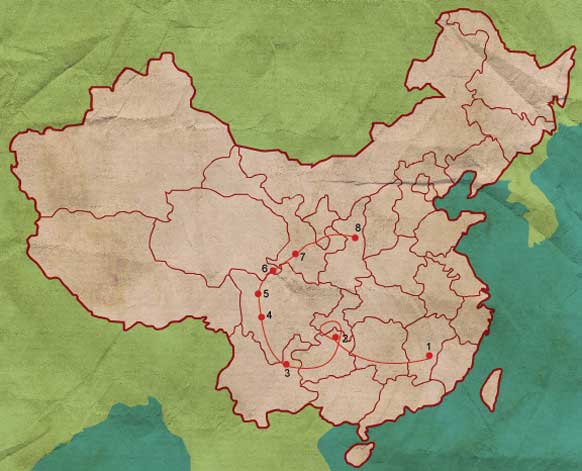The Long March and Yan'an experience
Historians have praised the Long March as a marathon of endurance and bravery:
- 'One of the great epic events of communist military history.' (Morales, 1986 p 90)
- '... an odyssey unequalled in modern times.' (Snow, 1968 p 190)
- 'One of the great exploits of military history unparalleled in the last 300 years.' (Mackerras, 1997 p 235)
Reasons for the Long March
The Long March was even more significant to CCP leadership and the development and spread of ideology.
Jiang Jieshi amended his tactics during the fifth Bandit Extermination campaign. Utilising German tactics, the Nationalist army partially encircled the Jiangxi Soviet. They used blockhouses, warlord support and air force and motorised divisions to force the Communists out of the soviet. The Communists began to suffer and did not have the military strength to defeat Jiang Jieshi's attack. A strategic retreat was their only option for survival.
The Communist escape, which began the Long March, was planned by Zhou Enlai. The aim of the March was to reach a soviet on the Hunan-Hubei border. However the Communists ended up marching over 9500 kilometres to the north Shaanxi province.
The Communists marched for over one year and endured mountains, Nationalist assaults, grasslands and severe cold.
Zhou negotiated a non-aggression pact, including the provision of medical supplies, with the warlord Chen Jitang who was guarding the south-west of the encirclement. About 100,000 marchers broke through this area from 21 October to 13 November 1934. They left a rear-guard army of about 28,000, many of whom were ill or wounded, to defend the soviet inhabited by women and children. Many of these perished when the Nationalists overran the soviet.
A series of photographs in the book The Long Revolution (Buggy 1988, pp 241-256) provide an excellent resource on the physical features along the route of the march.
 Click on the 'open' button below to learn more about the stages of The Long March: October 1934 to October 1935.
Click on the 'open' button below to learn more about the stages of The Long March: October 1934 to October 1935.
Text alternative The Long March: October 1934 to October 1935
The Long March: October 1934 to October 1935

There were eight stages to the Long March:
1. Ruijin to the Xiang River
2. Xiang River to Zunyi
3. Zunyi to Golden Sands River
4. Golden Sands River to Luding Bridge
5. Luding Bridge to Great Snowy Mountains
6. Great Snowy Mountains to the high grasslands
7. High grasslands to the Lazikou Pass
8. Lazikou Pass to Yan'an.






